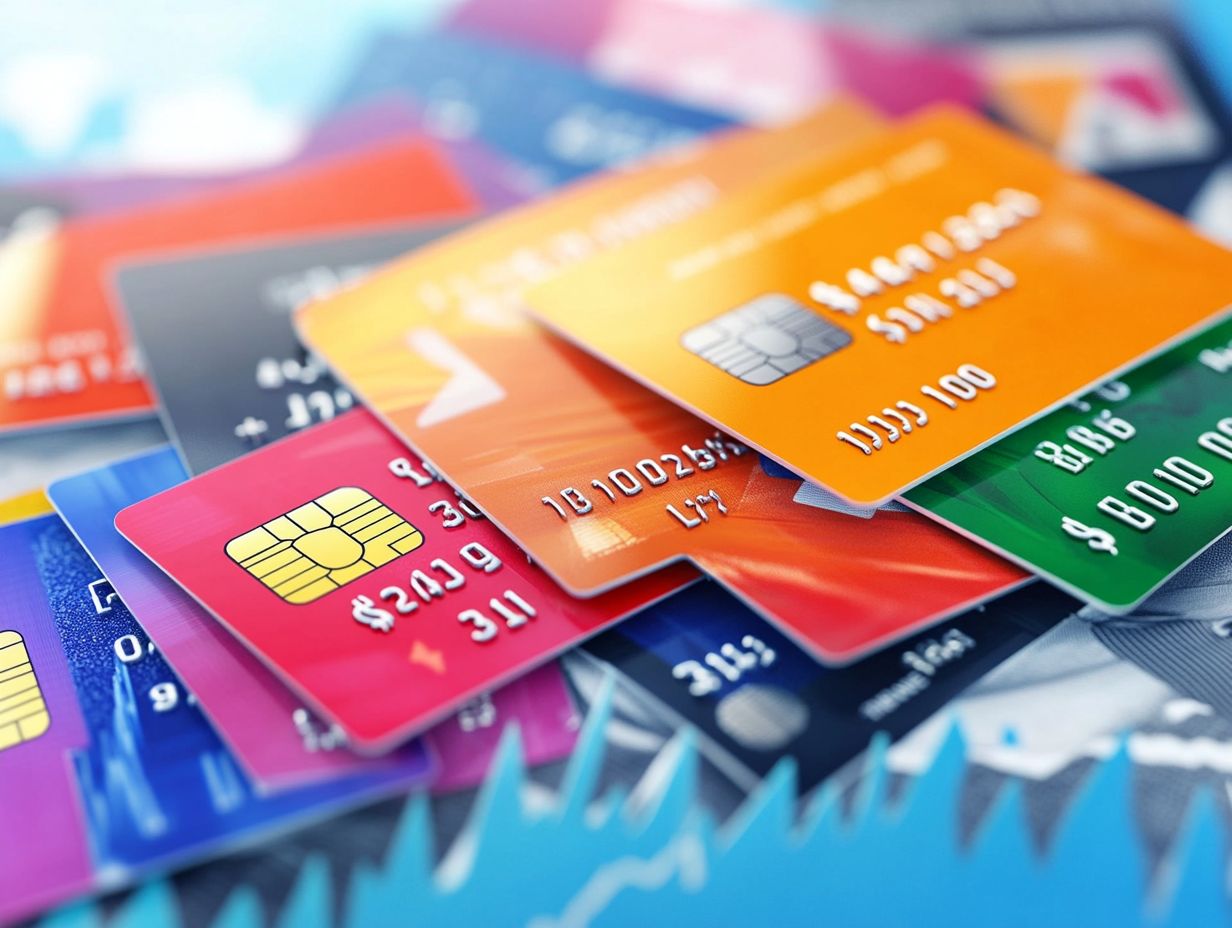Cash Back Cards: Which One Pays More?
Cash back cards offer a smart way for you to earn rewards on your everyday spending, transforming routine purchases into meaningful savings. Start earning cash back today and watch your savings grow!
This article delves into the intricacies of cash back cards, starting with an explanation of what they are and how they work. You’ll discover the different types available, such as flat rate versus rotating categories, and learn about essential factors to consider when choosing the right card for your needs.
You’ll also find strategies to maximize your cash back rewards, along with a comparison of the top options available today. Whether you re a seasoned pro or just stepping into the world of cash back, there s valuable insight here for anyone eager to make the most of their spending.
Contents
Key Takeaways:

- Earn a percentage back on your purchases.
- Match your card to your spending habits for the best rewards.
- Always compare fees and interest rates before choosing a card.
Unlock the Benefits of Cash Back Cards
If you want to earn the most rewards, understanding cash back cards is essential. These financial tools enable you to earn cash back on your purchases, which can either be redeemed for cash or applied toward future transactions. This flexibility makes them an appealing choice for the smart shopper.
With a range of offers from various partners and diverse card options available, it’s essential for you to grasp how cash back credit cards operate and the benefits they provide in today’s competitive financial landscape.
What are Cash Back Cards?
Cash back cards are an excellent option for you, rewarding you with a percentage of your spending back in cash. If you’re weighing your options, it’s helpful to understand the differences between cash back credit cards vs. rewards cards. They offer a straightforward and effective way to earn money on your everyday purchases.
Unlike other credit card options that might tempt you with points or travel rewards, these cards make the rewards easy to understand and use. This is especially beneficial if you prefer tangible financial returns. The cash rewards structure can vary: some cards provide a flat rate on all purchases, while others offer higher percentages for specific categories like groceries, gas, or dining out.
Many cash back cards come with no annual fee, making them a smart choice for the budget-conscious individual looking to maximize spending benefits. By opting for this route, you can enjoy the advantage of ongoing cash returns without the hassle of navigating complicated rewards systems.
How do They Work?
Cash back cards operate by offering you a percentage of cash back on eligible purchases, allowing you to earn rewards tailored to your spending habits.
This system encourages you to optimize your everyday expenses by focusing on specific categories that yield higher cash back percentages, such as groceries or gas. Once you’ve accumulated your cash back rewards, you can easily turn them into cash, statement credits, or gift cards, providing you with flexibility that suits your preferences.
Tracking your spending habits plays a vital role, as it helps you pinpoint your most rewarding categories while also aiding in your budgeting efforts. Many cash back cards come packed with enticing features like temporary low-interest rates, enhancing the benefits of your savvy spending. This makes it essential for you to thoroughly understand these options when choosing the right card for your lifestyle.
Types of Cash Back Cards
You ll find a variety of cash back cards available, each meticulously crafted to align with different spending habits and reward preferences. Whether you prefer flat-rate rewards, rotating categories, or travel rewards, there s a card tailored just for you.
Flat Rate vs. Rotating Categories

Flat rate cash back cards give you a consistent percentage back on every purchase. To maximize your rewards, it’s important to learn how to evaluate cash back card offers. Rotating category cards offer higher cash back rates in specific categories that change quarterly.
This creates notable differences in how your rewards accumulate. Each card type suits distinct spending habits.
If you prefer simplicity and make consistent purchases, a flat rate card might work best. It guarantees predictable returns regardless of where you spend.
If you can align your purchases with rotating categories, you can maximize your rewards, especially during promotional periods. For example, focusing on groceries can lead to significant benefits during months when grocery spending earns more cash back.
Store-Specific vs. General Use
Store-specific cash back cards offer attractive rewards for purchases made at particular retailers, while general-use cash back cards allow you to earn across various spending categories. It’s important to weigh the pros and cons of cash back credit cards to choose the best option for your needs.
These specialized cards often provide higher percentage returns for your loyalty to a single brand, encouraging you to maximize spending at that store. For instance, grocery giants like Walmart and Target offer cash back credit cards that significantly enhance your savings on everyday expenses.
Weigh these benefits against potential limitations, such as restricted earning potential beyond that specific retailer. On the other hand, general-use cash back cards typically reward a broader array of purchases, making them an excellent alternative if you prefer flexibility without being tied to specific brands. For more detailed insights, check out our guide on how to choose between cash back and rewards cards.
Factors to Consider When Choosing a Cash Back Card
When choosing a cash back card, it s essential to carefully evaluate several factors, including interest rates, fees, and the reward structure. This assessment ensures the card aligns perfectly with your financial goals and spending habits.
Interest Rates and Fees
Interest rates and fees can greatly influence the overall value of a cash back card. Choices range from no annual fee to various monthly fees and enticing promotional 0% APR offers.
Keep in mind that high interest rates can quickly overshadow any cash back rewards you might earn, especially if you can t pay off your balance in full each month.
Some cash back cards also come with transaction fees that can eat into your potential earnings. It s crucial to examine the fine print before making a decision.
Comparing multiple card options helps uncover hidden costs while finding a card that maximizes your rewards and minimizes overall expenses. Additionally, exploring cash back credit card offers and promotions ensures that cash back rewards truly deliver value.
Reward Structure and Redemption Options
The reward structure of a cash back card shapes how you earn rewards, and it can vary significantly. You have options for redeeming cash back through various methods like statement credits or travel rewards.
Understanding these variations can elevate your cash back strategy. Many cards offer tiered earning rates, meaning you earn different percentages based on where and how much you spend, especially in bonus categories like dining, groceries, or gas.
This alignment allows you to maximize your earnings when you choose to spend in those specific areas. Redemption options include direct transfers to your bank account, gift cards, or even charitable donations, giving you the flexibility to meet your financial needs or preferences.
By strategically aligning your spending with bonus categories and leveraging advantageous redemption methods, you can truly optimize your overall rewards potential.
Maximizing Cash Back Rewards

To maximize your cash back rewards, analyze your spending habits and strategically select cards and categories that resonate with those behaviors. This tailored approach allows you to achieve optimal returns on your purchases!
Tips and Strategies
Discover a wealth of tips and strategies to help maximize your cash back rewards. This includes making the most of specific cash back categories and utilizing additional financial services.
Align your spending habits with the rotating categories offered by cash back programs to significantly boost your earnings on everyday purchases. If dining out is a regular indulgence, use credit cards that offer higher cash back rates during restaurant promotions. Tap into loyalty programs linked to your cash back accounts to unlock even greater savings.
By combining these strategies with financial services that provide budgeting tools which help you plan your spending and expense tracking, you can make informed decisions that not only optimize your cash back returns but also enhance your overall financial wellness.
Comparing Top Cash Back Cards
When comparing top cash back cards, examining key features like cash rewards rates, fees, and various card options tailored to your financial needs is essential.
This thoughtful analysis empowers you to make an informed decision that aligns perfectly with your spending habits and financial goals.
Key Features and Benefits
Key features of cash-back cards include competitive cash rewards rates, no annual fees, and perks that enhance your cardmember experience.
Many cash-back cards attract new users with appealing welcome bonuses. For instance, a card offering an initial bonus after meeting a spending threshold can significantly enhance your value in those early months.
The absence of foreign transaction fees is particularly appealing for frequent travelers, allowing you to make global purchases without worrying about extra charges. Unique card perks, like extended warranties or access to exclusive events, further enrich your experience, showing how these cards cater to diverse lifestyles and preferences.
Frequently Asked Questions
What are cash back cards?

Cash back cards are credit cards that offer a percentage of your spending as a rebate or reward. For every purchase made, a certain amount is credited back to your account, allowing you to maximize your benefits through cash back rewards.
How do cash back cards work?
Cash back cards give cardholders a percentage of their purchases back in cash or statement credits. This varies by card, so it’s important to read the terms and conditions, especially when comparing cash back credit cards to understand how rewards are earned and redeemed.
Which cash back card pays more?
The cash back card that pays more depends on your spending habits and the card’s rewards structure. Some cards offer higher rewards for specific categories like groceries or gas, while others have a flat rate on all purchases. Comparing different cash back credit cards helps you find the one that pays the most based on your spending patterns.
Are there any limitations to cash back cards?
Yes, limitations can include a minimum spending requirement, caps on earned rewards, or specific categories that do not qualify for cash back. Reading the terms and conditions will help you understand these limitations.
What should I consider when choosing a cash back card?
When selecting a cash back card, consider the rewards structure, any limitations or fees, and how well the rewards align with your spending habits. Also, look at the interest rate and ensure you can pay off the balance in full each month to avoid interest charges.
Is it worth getting a cash back card?
It depends on your spending habits and the card’s rewards structure. If you can pay off the balance in full each month and the rewards match your spending, a cash back card can be a great way to earn extra money. However, if you carry a balance, the interest charges may outweigh the rewards earned.
Ready to maximize your cash back rewards?
Explore the best cash back cards available today and start reaping the benefits!






